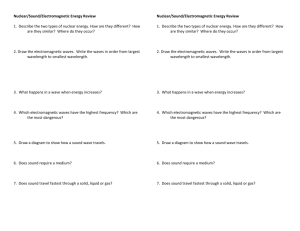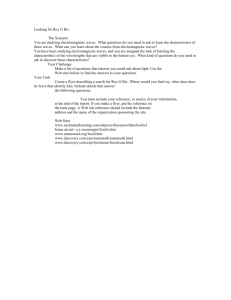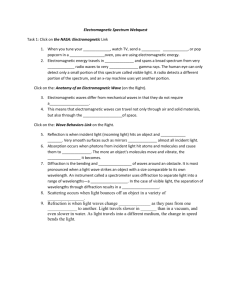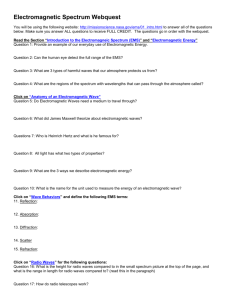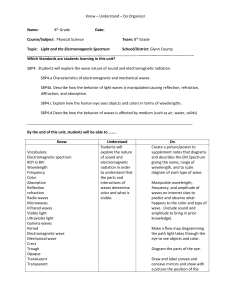Light Waves and Matter - The Physics Classroom
advertisement
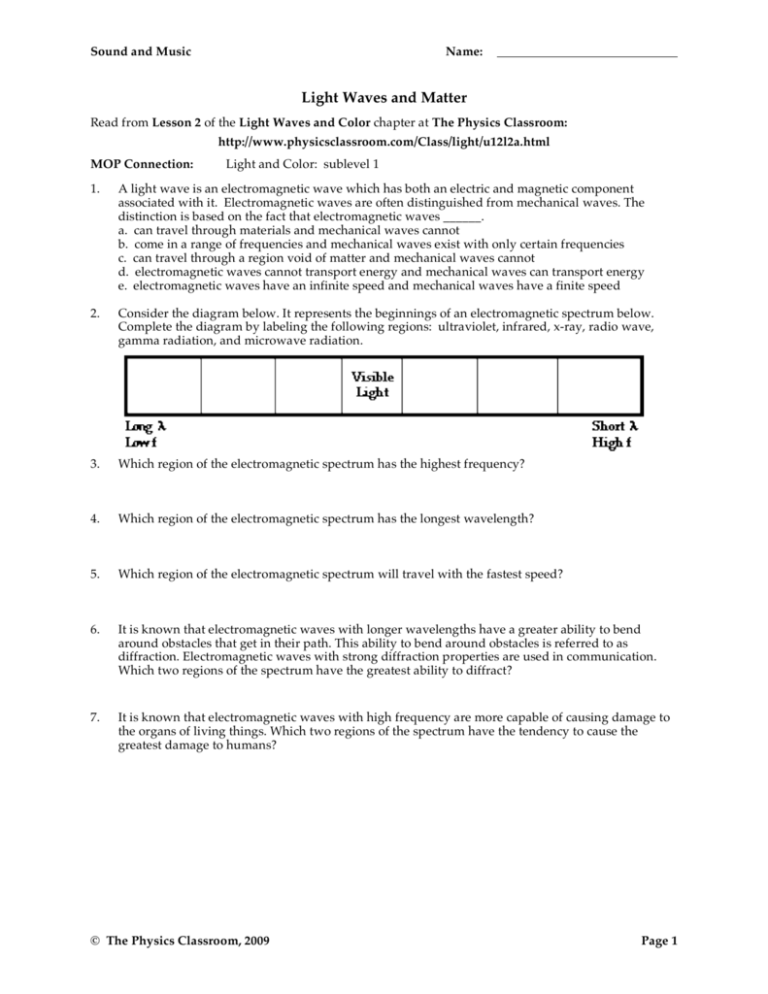
Sound and Music Name: Light Waves and Matter Read from Lesson 2 of the Light Waves and Color chapter at The Physics Classroom: http://www.physicsclassroom.com/Class/light/u12l2a.html MOP Connection: Light and Color: sublevel 1 1. A light wave is an electromagnetic wave which has both an electric and magnetic component associated with it. Electromagnetic waves are often distinguished from mechanical waves. The distinction is based on the fact that electromagnetic waves ______. a. can travel through materials and mechanical waves cannot b. come in a range of frequencies and mechanical waves exist with only certain frequencies c. can travel through a region void of matter and mechanical waves cannot d. electromagnetic waves cannot transport energy and mechanical waves can transport energy e. electromagnetic waves have an infinite speed and mechanical waves have a finite speed 2. Consider the diagram below. It represents the beginnings of an electromagnetic spectrum below. Complete the diagram by labeling the following regions: ultraviolet, infrared, x-ray, radio wave, gamma radiation, and microwave radiation. 3. Which region of the electromagnetic spectrum has the highest frequency? 4. Which region of the electromagnetic spectrum has the longest wavelength? 5. Which region of the electromagnetic spectrum will travel with the fastest speed? 6. It is known that electromagnetic waves with longer wavelengths have a greater ability to bend around obstacles that get in their path. This ability to bend around obstacles is referred to as diffraction. Electromagnetic waves with strong diffraction properties are used in communication. Which two regions of the spectrum have the greatest ability to diffract? 7. It is known that electromagnetic waves with high frequency are more capable of causing damage to the organs of living things. Which two regions of the spectrum have the tendency to cause the greatest damage to humans? © The Physics Classroom, 2009 Page 1 Sound and Music Light that the human eye is capable of detecting is known as visible light. There is a range of frequencies that the eye can detect. Various frequencies are observed as different colors. The diagram below represents the range or spectrum of visible light frequencies labeled with their respective colors. 8. Which color of the visible light spectrum has the highest frequency? 9. Which color of the visible light spectrum has the longest wavelength? 10. Light and material objects always interact in one way or another. When light is incident on some materials, it is transmitted through the material. For instance, visible light is transmitted through glass. Glass is said to be _______ to visible light. a. transparent b. opaque 11. Other materials absorb and/or reflect light only. They do not allow light to pass through it. Such materials are said to be ________. a. transparent b. opaque 12. Some material objects are transparent to certain forms of electromagnetic waves but opaque to other forms. Earth's atmosphere is an example. The atmosphere allows visible light to pass through it. Much of the more damaging portion of the ultraviolet spectrum is blocked by a thin layer of ozone in the stratosphere. The atmosphere is said to be ____________________________ (transparent, opaque) to visible light but _____________________________ (transparent, opaque) to ultraviolet light. 13. As light passes through transparent objects, the speed at which it travels is __________. a. the same speed as it travels through air b. less than the speed at which it travels through air c. greater than the speed at which it travels through air © The Physics Classroom, 2009 Page 2


